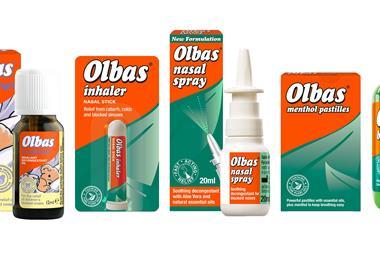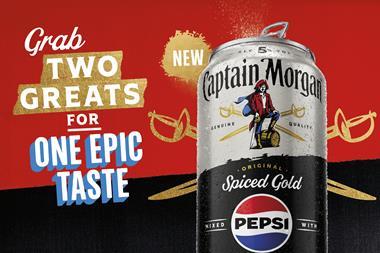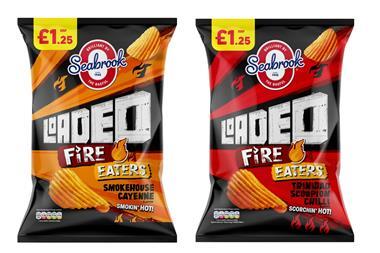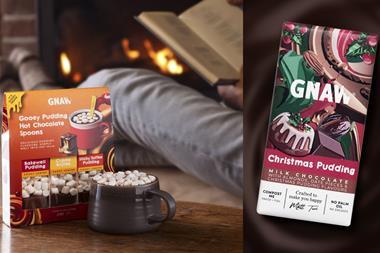As the supermarkets continue to wage war on each other, the butters and spreads category remains heavily reliant on promotions. "There has been an increased level of promotional activity within the butters and spreads category, which has resulted in a value decline as shoppers buy into larger packs at a lower price," explains Unilever Partners for Growth manager Kimberley Green.
This has made it nigh-on impossible for c-stores to match the supermarkets on price. "It's extremely difficult to compete on price with the multiples," says Jitesh Parmar, who runs Best One Food & Wine in Bletchley, Milton Keynes. "We price I Can't Believe It's Not Butter at £1.64 for 500g, but Morrisons was selling it for 50p recently."
In fact, the supermarkets offer such deep discounts that Jitesh finds himself buying stock from them to save money. "If I were to buy a 500g pack of Clover through Best One I would have to sell it at £2.50 to make a reasonable margin. Instead, I buy it from Sainsbury's it's much cheaper, plus I can buy it in smaller quantities of just six or seven packs, rather than an outer."
While the situation is far from ideal, butters and spreads suppliers claim that they are supportive of the independent sector. Kerrygold has launched a smaller case specifically for the convenience market (packet butter 10s and Softer in eights), offering c-stores a quicker turnover of stock with minimum wastage.
And Dairy Crest introduced Utterly Butterly and Clover 100% extra-free packs targeted at c-stores over the summer. The company is also considering introducing more pricemarked packs. "Pricemarking is a way of offering value to consumers without taking value from the category," says head of marketing Nathan King.
"If you look at the macro environment, competitiveness on price is set to be with us for a while. We'll be reviewing whether to add more pricemarked packs in the future."
Price promotions are likely to continue throughout the recession, agrees Arla Foods business unit director Danny Micklethwaite. "However, it's likely that the number of promotions will reduce and possibly the level of discount will lessen. This should help to increase category value again as we come out of recession."
And while the end of deep discounting may be in sight, competition among brands for consumer loyalty shows no sign of abating. The butters and spreads market has become a hive of activity in recent years with brands battling it out to win over consumers.
Anchor Butter has come back fighting following Country Life's attack on Anchor's New Zealand roots with a new £10m marketing campaign. Rather than directly retaliating to its rival's jibes, Anchor has side-stepped the country of origin issue altogether. Instead, its advertising hones in on the brand's long history, while raising a few laughs by showing butter being manufactured by a herd of cows and the tagline 'Made by cows since 1886'. "The new TV advertising takes the brand in a very different direction, which will undoubtedly generate consumer excitement in the brand, reminding them of the reasons to purchase Anchor," says Anchor senior brand manager Mike Walker. "The advert successfully communicates the heritage of Anchor using our famous Anchor cows, which we know appeal strongly to consumers."
While the brand continues to sell well, it can't afford to rest on its laurels as adversary Country Life is chomping at the bit to steal market share. "Country Life is worth £6m in convenience, up 20% year on year," says Dairy Crest head of marketing Nathan King.
"The spreadable part of the brand is up 57% year on year. Contrast that with Anchor, which is worth £9m, but down 11% we're hot on their heels."
With butters and spreads penetration approaching 99%, most consumers have already aligned themselves with a particular brand.
"An amazing 90% of butters and spreads shoppers already know which brand of butter or margarine they want before they set foot inside a store," notes Green.
It therefore takes a lot to get people to upgrade or switch brands. "If you want people to try something else, you have to do something new and different to break them out of their behaviour cycle," says King. He claims that raising awareness of Country Life's British origins through adverts starring John Lydon has encouraged a large number of consumers to convert to the brand.
"The John Lydon advertising continues to work well in driving awareness of Country Life as a British brand, while highlighting Anchor as a New Zealand export.
"A study done by YouGov in May 2009 showed that 29% of people thought Anchor was British, whereas 18 months ago it was 39%."
He claims that the decline can be partly traced back to Country Life's advertising and that Dairy Crest's British brand is reaping the benefits. "We have no issue with imported products, or the quality of Anchor, but if you give people the facts then they can make their own decisions. You can infer that some people are finding out that Anchor is made in New Zealand and then switching to Country Life."
To further establish itself as the ultimate British butter, the brand recently announced its support for the Prince of Wales Countryside Fund. It has added the Fund's logo to its block butter, and spreadable packs will follow suit over the next couple of months.
Provenance also plays a major role in the marketing of Kerrygold butter, which has gone from strength to strength since unveiling its 'Owned by Irish farmers' slogan last year. Having run a successful TV advertising campaign last year where the farmers filmed themselves working together to make Kerrygold, the brand has launched the Kerrygold Community Awards, which reward communities that work together to achieve a common goal.
"The community awards are a uniting platform, which have resonated well with consumers, creating excellent standout on shelf and driving strong sales and loyalty," says Kerrygold brand marketing controller Alison Palmer.
She also claims that Kerrygold is benefiting from the ongoing consumer trend towards natural products. Palmer adds: "We have continued to see a general market trend for consumers demanding pure, natural products."
Arla Foods' Micklethwaite concurs. "The main trend in the butters and spreads category over the past couple of years has been consumers moving towards more natural and tasty products, and away from those packed full of additives. This coincides with the decline in the consumer making a purchasing decision based on health, as seen by the decline of the low-fat sector."
He claims that consumers have wised up to what's in their food and are making far more educated decisions as a result. "We have found that consumers are increasingly following an 'everything in moderation' approach and are looking at a more holistic view on health. They are not just looking at the saturated fat content anymore, but are instead weighing up all the pros and cons. They understand that some products may be lower in fat, but are also full of e numbers, additives, preservatives and stabilizers to compensate for that reduction.
"Our research shows that many consumers are switching away from these products to the more natural and taste-led sectors such as spreadables and block butter, because they trust these more."
Brands such as Clover, which has had plenty of media presence in recent months with its 'Great in the middle' campaign, plays very much on consumers' desire for the best of both worlds. "Clover is quite provocative as it's asking 'what's wrong with the middle?'" says King. "While it is important to give consumers additional benefits, this shouldn't be at the expense of taste. Clover is the epitome of this."
This summer Unilever's olive oil-based spread Bertolli underwent a recipe reformulation to make it tastier; and a Flora Pro Activ buttery variant was launched. "Buttery spreads is the fastest growing segment within the total grocery butters and spreads category as taste is a key driver for consumers, even those concerned with health," says Flora Pro Activ brand manager Caroline Banquet. "A massive 61% of those who tested Flora Pro Activ Buttery said it tastes as good as butter, so this offers a great opportunity to grow the butter and spreads category."
However, Dairy Crest's King notes that while dairy spreads account for a massive 28% of value sales across butters and spreads within convenience, and are up 7% in year-on-year volume sales, they are down 0.6% in value sales. By comparison, he claims that spreadable butters account for a quarter of value sales, and are up 4% year on year in value and 6% in volume. "We're advising retailers to give a little more room to spreadable butters. Spreadable butter is even more of a growth area in c-stores than in grocery."
Says Kerrygold's Palmer: "Spreadable butters are becoming increasing important to the consumer. Spreadable butter is the fastest growing sector and worth more than the packet market in value sales. Therefore, if a store stocks a packet butter it should be merchandised alongside a softer butter so different consumer needs can be met."
Retailers also need to meet consumer demands for an assortment of pack sizes, she claims. "Choice of sizes is key. We have just run some analysis that shows the 250g and 500g softer butter users are very different consumers with different need sets. They are also very loyal to their pack size, very rarely swapping between the two pack sizes, even if one is on promotion."
Therefore, she recommends that retailers stock both a 250g and a 500g spreadable butter if space allows. "Only stocking one size could be failing to give customers what they want and they could go somewhere else for their purchase," she says. "For example, the consumer who buys the 250g format is typically from a small household and is looking for a pack that is suitable for their needs. They do not want the product to go off (and therefore be a waste) so would be reluctant to purchase a 500g pack as it would be too big for their consumption.
"Meanwhile, the buyer of the 500g pack is often from a larger household who requires a pack size to suit their lifestyle and one that will last until their next shop."
Ensuring the right selection of products by using a planogram is vital, as is product placement, claims Arla. "Best-selling products should be placed in eye-catching areas within the chiller in order to maximise sales and encourage browsing. Eye level within this category is traditionally mid-level to the base of the chiller," says Micklethwaite.
He claims that stocking all your dairy products together helps to signpost the section, and ensuring staff are knowledgeable about products can also boost sales. "By doing these things, retailers will increase shopper understanding of the breadth of the products on offer, so encouraging trade-up as the browsing time is increased."
This has made it nigh-on impossible for c-stores to match the supermarkets on price. "It's extremely difficult to compete on price with the multiples," says Jitesh Parmar, who runs Best One Food & Wine in Bletchley, Milton Keynes. "We price I Can't Believe It's Not Butter at £1.64 for 500g, but Morrisons was selling it for 50p recently."
In fact, the supermarkets offer such deep discounts that Jitesh finds himself buying stock from them to save money. "If I were to buy a 500g pack of Clover through Best One I would have to sell it at £2.50 to make a reasonable margin. Instead, I buy it from Sainsbury's it's much cheaper, plus I can buy it in smaller quantities of just six or seven packs, rather than an outer."
While the situation is far from ideal, butters and spreads suppliers claim that they are supportive of the independent sector. Kerrygold has launched a smaller case specifically for the convenience market (packet butter 10s and Softer in eights), offering c-stores a quicker turnover of stock with minimum wastage.
And Dairy Crest introduced Utterly Butterly and Clover 100% extra-free packs targeted at c-stores over the summer. The company is also considering introducing more pricemarked packs. "Pricemarking is a way of offering value to consumers without taking value from the category," says head of marketing Nathan King.
"If you look at the macro environment, competitiveness on price is set to be with us for a while. We'll be reviewing whether to add more pricemarked packs in the future."
Price promotions are likely to continue throughout the recession, agrees Arla Foods business unit director Danny Micklethwaite. "However, it's likely that the number of promotions will reduce and possibly the level of discount will lessen. This should help to increase category value again as we come out of recession."
And while the end of deep discounting may be in sight, competition among brands for consumer loyalty shows no sign of abating. The butters and spreads market has become a hive of activity in recent years with brands battling it out to win over consumers.
Anchor Butter has come back fighting following Country Life's attack on Anchor's New Zealand roots with a new £10m marketing campaign. Rather than directly retaliating to its rival's jibes, Anchor has side-stepped the country of origin issue altogether. Instead, its advertising hones in on the brand's long history, while raising a few laughs by showing butter being manufactured by a herd of cows and the tagline 'Made by cows since 1886'. "The new TV advertising takes the brand in a very different direction, which will undoubtedly generate consumer excitement in the brand, reminding them of the reasons to purchase Anchor," says Anchor senior brand manager Mike Walker. "The advert successfully communicates the heritage of Anchor using our famous Anchor cows, which we know appeal strongly to consumers."
While the brand continues to sell well, it can't afford to rest on its laurels as adversary Country Life is chomping at the bit to steal market share. "Country Life is worth £6m in convenience, up 20% year on year," says Dairy Crest head of marketing Nathan King.
"The spreadable part of the brand is up 57% year on year. Contrast that with Anchor, which is worth £9m, but down 11% we're hot on their heels."
With butters and spreads penetration approaching 99%, most consumers have already aligned themselves with a particular brand.
"An amazing 90% of butters and spreads shoppers already know which brand of butter or margarine they want before they set foot inside a store," notes Green.
It therefore takes a lot to get people to upgrade or switch brands. "If you want people to try something else, you have to do something new and different to break them out of their behaviour cycle," says King. He claims that raising awareness of Country Life's British origins through adverts starring John Lydon has encouraged a large number of consumers to convert to the brand.
"The John Lydon advertising continues to work well in driving awareness of Country Life as a British brand, while highlighting Anchor as a New Zealand export.
"A study done by YouGov in May 2009 showed that 29% of people thought Anchor was British, whereas 18 months ago it was 39%."
He claims that the decline can be partly traced back to Country Life's advertising and that Dairy Crest's British brand is reaping the benefits. "We have no issue with imported products, or the quality of Anchor, but if you give people the facts then they can make their own decisions. You can infer that some people are finding out that Anchor is made in New Zealand and then switching to Country Life."
To further establish itself as the ultimate British butter, the brand recently announced its support for the Prince of Wales Countryside Fund. It has added the Fund's logo to its block butter, and spreadable packs will follow suit over the next couple of months.
Provenance also plays a major role in the marketing of Kerrygold butter, which has gone from strength to strength since unveiling its 'Owned by Irish farmers' slogan last year. Having run a successful TV advertising campaign last year where the farmers filmed themselves working together to make Kerrygold, the brand has launched the Kerrygold Community Awards, which reward communities that work together to achieve a common goal.
"The community awards are a uniting platform, which have resonated well with consumers, creating excellent standout on shelf and driving strong sales and loyalty," says Kerrygold brand marketing controller Alison Palmer.
She also claims that Kerrygold is benefiting from the ongoing consumer trend towards natural products. Palmer adds: "We have continued to see a general market trend for consumers demanding pure, natural products."
Arla Foods' Micklethwaite concurs. "The main trend in the butters and spreads category over the past couple of years has been consumers moving towards more natural and tasty products, and away from those packed full of additives. This coincides with the decline in the consumer making a purchasing decision based on health, as seen by the decline of the low-fat sector."
He claims that consumers have wised up to what's in their food and are making far more educated decisions as a result. "We have found that consumers are increasingly following an 'everything in moderation' approach and are looking at a more holistic view on health. They are not just looking at the saturated fat content anymore, but are instead weighing up all the pros and cons. They understand that some products may be lower in fat, but are also full of e numbers, additives, preservatives and stabilizers to compensate for that reduction.
"Our research shows that many consumers are switching away from these products to the more natural and taste-led sectors such as spreadables and block butter, because they trust these more."
Brands such as Clover, which has had plenty of media presence in recent months with its 'Great in the middle' campaign, plays very much on consumers' desire for the best of both worlds. "Clover is quite provocative as it's asking 'what's wrong with the middle?'" says King. "While it is important to give consumers additional benefits, this shouldn't be at the expense of taste. Clover is the epitome of this."
retailer’s view
"Butters and spreads are a steady seller. I stock Anchor, Kerrygold, Flora and either Utterly Butterly or I Can't Believe It's Not Butter whichever is on special.
There's always one of them on offer at the cash and carry, and if not then the supermarkets have great offers. They always have one butter at £1 per pack and I don't have to buy a whole outer.
Also, butter at the supermarkets tends to have double the shelf-life of what's available on wholesale. "Spreadable butters are doing well it's the ease of spreading that really appeals to consumers.
"I can't say I've witnessed any demand for British butter. We stock Anchor because that's what people are used to it's what many have grown up with. I don't think its New Zealand roots bother anyone."
Roger Dicker, Kentford Village Stores, Newmarket, Suffolk
Consumers' refusal to substitute taste for health also goes some way towards explaining recent changes in the more health-focused camp, where taste has also become a key focal point. "Butters and spreads are a steady seller. I stock Anchor, Kerrygold, Flora and either Utterly Butterly or I Can't Believe It's Not Butter whichever is on special.
There's always one of them on offer at the cash and carry, and if not then the supermarkets have great offers. They always have one butter at £1 per pack and I don't have to buy a whole outer.
Also, butter at the supermarkets tends to have double the shelf-life of what's available on wholesale. "Spreadable butters are doing well it's the ease of spreading that really appeals to consumers.
"I can't say I've witnessed any demand for British butter. We stock Anchor because that's what people are used to it's what many have grown up with. I don't think its New Zealand roots bother anyone."
Roger Dicker, Kentford Village Stores, Newmarket, Suffolk
This summer Unilever's olive oil-based spread Bertolli underwent a recipe reformulation to make it tastier; and a Flora Pro Activ buttery variant was launched. "Buttery spreads is the fastest growing segment within the total grocery butters and spreads category as taste is a key driver for consumers, even those concerned with health," says Flora Pro Activ brand manager Caroline Banquet. "A massive 61% of those who tested Flora Pro Activ Buttery said it tastes as good as butter, so this offers a great opportunity to grow the butter and spreads category."
However, Dairy Crest's King notes that while dairy spreads account for a massive 28% of value sales across butters and spreads within convenience, and are up 7% in year-on-year volume sales, they are down 0.6% in value sales. By comparison, he claims that spreadable butters account for a quarter of value sales, and are up 4% year on year in value and 6% in volume. "We're advising retailers to give a little more room to spreadable butters. Spreadable butter is even more of a growth area in c-stores than in grocery."
Says Kerrygold's Palmer: "Spreadable butters are becoming increasing important to the consumer. Spreadable butter is the fastest growing sector and worth more than the packet market in value sales. Therefore, if a store stocks a packet butter it should be merchandised alongside a softer butter so different consumer needs can be met."
Retailers also need to meet consumer demands for an assortment of pack sizes, she claims. "Choice of sizes is key. We have just run some analysis that shows the 250g and 500g softer butter users are very different consumers with different need sets. They are also very loyal to their pack size, very rarely swapping between the two pack sizes, even if one is on promotion."
Therefore, she recommends that retailers stock both a 250g and a 500g spreadable butter if space allows. "Only stocking one size could be failing to give customers what they want and they could go somewhere else for their purchase," she says. "For example, the consumer who buys the 250g format is typically from a small household and is looking for a pack that is suitable for their needs. They do not want the product to go off (and therefore be a waste) so would be reluctant to purchase a 500g pack as it would be too big for their consumption.
"Meanwhile, the buyer of the 500g pack is often from a larger household who requires a pack size to suit their lifestyle and one that will last until their next shop."
Ensuring the right selection of products by using a planogram is vital, as is product placement, claims Arla. "Best-selling products should be placed in eye-catching areas within the chiller in order to maximise sales and encourage browsing. Eye level within this category is traditionally mid-level to the base of the chiller," says Micklethwaite.
He claims that stocking all your dairy products together helps to signpost the section, and ensuring staff are knowledgeable about products can also boost sales. "By doing these things, retailers will increase shopper understanding of the breadth of the products on offer, so encouraging trade-up as the browsing time is increased."
top tips
Site butters and spreads next to cheese and milk
Concentrate on cleanliness keep your chiller spotless.
Chilled is the hygiene benchmark for your store Don't mark down out-of-date stock it gives the wrong impression. Clear to waste instead.
Understand your sales peaks record them and then replenish the range regularly
Help customers shop keep your range, segmentation and fixture communication simple to make life easy for shoppers.
Source: Dairy Crest
Site butters and spreads next to cheese and milk
Concentrate on cleanliness keep your chiller spotless.
Chilled is the hygiene benchmark for your store Don't mark down out-of-date stock it gives the wrong impression. Clear to waste instead.
Understand your sales peaks record them and then replenish the range regularly
Help customers shop keep your range, segmentation and fixture communication simple to make life easy for shoppers.
Source: Dairy Crest




























No comments yet